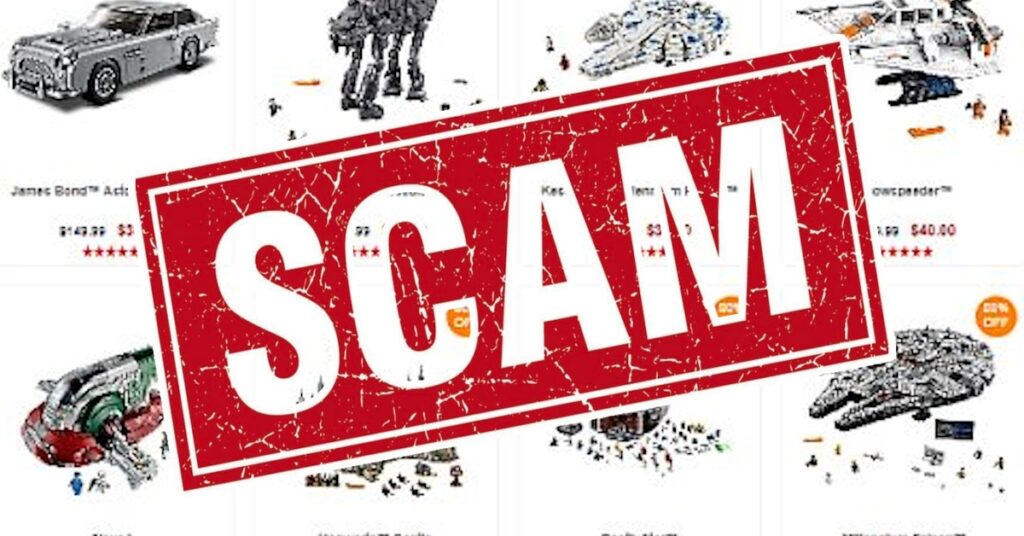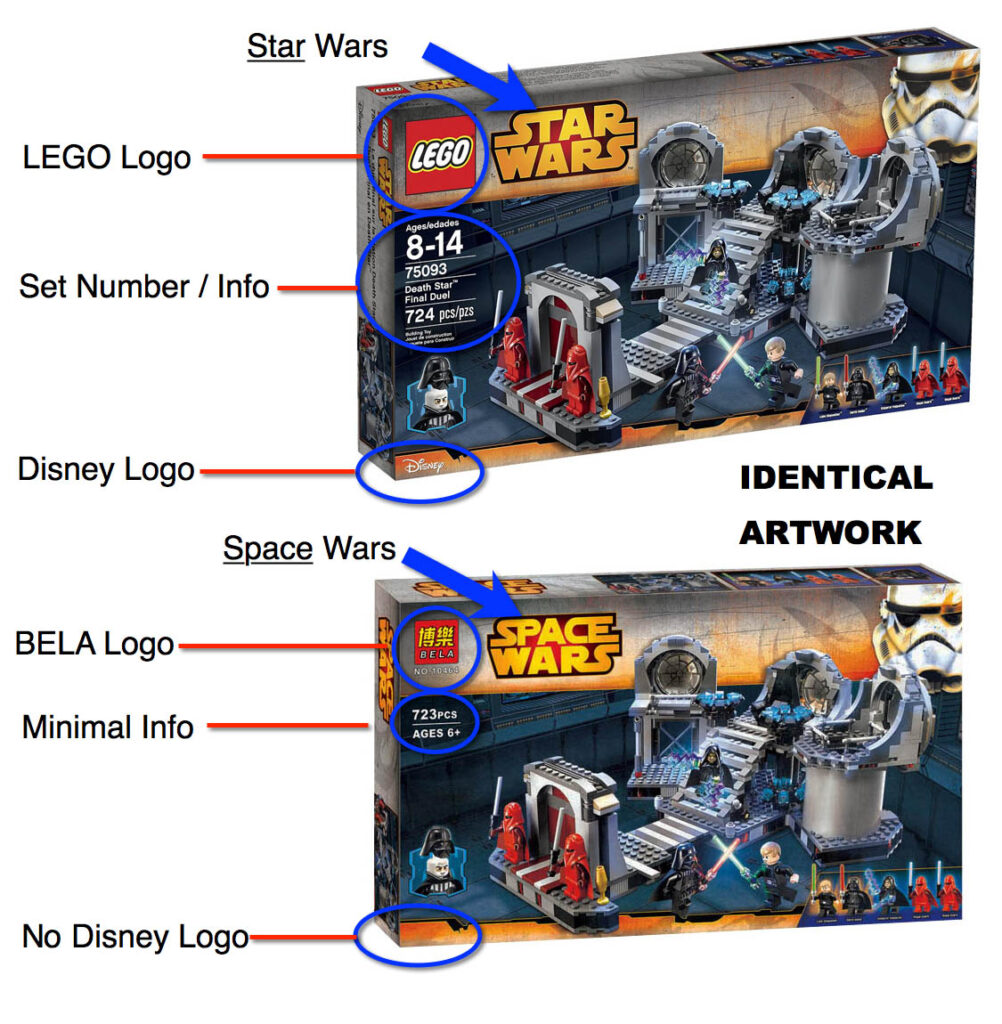
With the growing popularity of LEGO sets – especially those from a galaxy far, far away – and holiday shopping season fast approaching, the number of fraudulent LEGO sellers is on the rise. Being able to spot them and avoid getting scammed is more important than ever, so guest writer Steve Weimer has collected his in-depth knowledge of the clone LEGO brand market and tapped into his own personal experiences to put together a guide on how to ensure your purchases aren’t going to lead to a hole in your collection or wallet.
As parents we all want to buy our kids cool things and keep our budgets within the size of our wallets, and as collectors, we know that the entry fee into the LEGO Star Wars community is pretty high because many LEGO Star Wars sets – especially when it comes to the bigger UCS sets – are not cheap, so looking for deals is a common practice, and as a result, many fans have been taken in by advertisements for discounted LEGO sets.
This isn’t a new phenomenon and has been going on for several years, but I (as well as LEGO, who produced their own guide to spotting a fake LEGO webstore) personally have seen this problem greatly increase since 2020 with the COVID-19 pandemic forcing people to stay at home and shop online more.
The situation is probably going to be similar this year, and with it being international fraud awareness week I thought it would be a good time to go over a few things.
I remember last year I really started to see a lot more pop-up ads on social sites. A lot of these ads would redirect you to a bogus site or offer a UCS Death Star set for the low, low price of$179. Don’t be fooled – if you see an ad that has discounted rates then just simply stay away, I guarantee you it’s not legit and you may be putting your credit card or computer’s safety at risk by clicking on the link.
Perhaps the most common way to part LEGO fans from their money are the fake websites that pretend to be official LEGO sellers – or even try to pass themselves off as the official LEGO website.
These sites, which are usually promoted on popular social media platforms, often look genuine. Many feature the LEGO logo, theme logos, photos of real LEGO sets, and a similar design to the official LEGO webstore.

Fake sites often will use addresses like LEGOfanstore.com, LEGOdeals.com, or LEGOvipclub.com to advertise their products. To people who don’t know better, it’s easy to get check out these sites because it has the LEGO name in them.
There are a few things you can always check out to see if it is a legitimate retailer.
- Look at the contents of the site. Does it seem legit? Are there misspelled words or sentences that don’t make sense? Also, make sure that the pictures of the products are of clear quality as sometimes fake sites will use stock photos from another site and turn out fuzzy.
- Check out customer reviews on the site. Even though these can be faked as well, one thing to look at is if you are able to leave a review yourself. There should be a little box somewhere to leave comments or questions.
- Make sure that the site is secure – meaning any data (such as personal details and banking or credit card numbers) being passed from your browser to the retailer is encrypted – if it says “not secure” on your browser then you should avoid it.
- If you do buy from a site other than LEGO, make sure you pay with either a credit or debit card. Most of the time this form of payment is more protected if you need to file a claim or get your money back with ease if you did get scammed.
- Buy from well known retail sites, and not wholesalers. A lot of of these sites – like Alliexpress – have multiple accounts that sell fake Star Wars brick sets. Many of them these days have no brand logo or may use names like CB, Monarch, Lion King and SY, and hide terms like LEGO compliant or compatible in their product descriptions.
While heavily discounted sets may be enticing, LEGO does not advertise or run sales on social media platforms or community marketplaces, and while the likes of Facebook, Craig’s List, and Gumtree are getting better at policing fraudulent sales, a few do slip through.

The best way to avoid getting scammed through personal classifieds sales is to join a reputable LEGO Star Wars group on Facebook where the admins and members will police sales posts and weed out scammers. If you’re still not sure then do some of your own fact-finding (like a reverse image search) and ask for
At the end of the day, the best way to shop online for LEGO products is through the main LEGO website or from a reputable retailer – like Walmart, Target, or Amazon – that you are familiar with. This will save you a lot of headaches in the end and possibly a lot of money.
If you see a potentially fraudulent or scam website claiming to sell LEGO products, please contact LEGO customer service and, if on social media, report the ad to the site or groups administrators. If all this advice comes too late then you should contact the transaction service you used to pay for the goods, as well as the relevant consumer protection agency.
Finally, let’s talk about fake LEGO bricks because this is the most common result of purchasing cheap Star Wars sets at wholesale retailers or from bogus advertisements.
The easiest way to tell is to simply look at the packaging itself because there will be plenty of clues in the artwork and graphics.

Next, take a look at top of the pieces; all bonafide LEGO brand sets have the LEGO logo on each and every stud, whether it be a plate, brick, or minifigure head. The biggest giveaway is that they will not have the proper LEGO logo on the top studs.
The brick itself will have nice sharp edges and a rigid structure that will make it easier to keep the pieces stay together nicely when put together. As far as color, LEGO is pretty uniform with the brick colors from set to set. In other words, a dark gray brick on the UCS Millennium Falcon is going to be the same shade/color as a dark gray brick in a Death Star set. The quality of the minifigures from set to set is consistent, with nice sharp paint detail, and are easy to put together.
For the most part, the quality of these fake bricks is subpar at best. Some clone brands produce good quality bricks, similar to that of LEGO – Lepin is probably the best known fake brand – but most of the other smaller clone brands are quite shoddy and a lot of their bricks are don’t fit together particularly well.
Sometimes you will also notice differences in the color of the bricks especially if you compare it to an actual LEGO brick. It may be a shade lighter or darker but there’ll be enough difference to spot. A lot of the time the bricks on fake sets will also not have the nice fine sharp edges like they should and could break easily.
It’s the same with the minifigures; the quality is not there and a lot of the time the printing detail on the legs and torse, as well as the facial features can be quite horrible.
The bottom line is if something looks too good to be true then it is – buyer be warned!


this shod stop